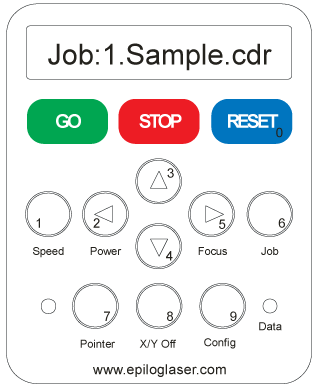Difference between revisions of "Introduction to the Zing Laser"
Jump to navigation
Jump to search
(→Raster) |
|||
| Line 21: | Line 21: | ||
==== Raster==== | ==== Raster==== | ||
*Raster Images are made of pixels and will be engraved. Common examples would be photos or images found online | *Raster Images are made of pixels and will be engraved. Common examples would be photos or images found online | ||
| − | * The cutter software will take your raster image and convert it into greyscale with each pixel being represented by a dot | + | * The cutter software will take your raster image and convert it into greyscale with each pixel being represented by a dot |
*The laser will pulse on and off as it follows these series of dots to create the image | *The laser will pulse on and off as it follows these series of dots to create the image | ||
| − | *The cutter achieves fine resolution by adjusting the power of the laser dependent on the darkness/lightness of the dot | + | *The cutter achieves fine resolution by adjusting the power of the laser dependent on the darkness/lightness of the dot |
| + | |||
====Vector==== | ====Vector==== | ||
*Vector images are made of points and lines that connect points. | *Vector images are made of points and lines that connect points. | ||
Revision as of 17:08, 26 December 2023
Safety
- To avoid the risk of fire, never leave the laser running unattended.
- Never run the Zing without the ventilation fans running. The interaction of the laser and the material generates fumes.
- The laser wavelength is such that the glass cover protects the eyes of the user. Do not attempt to run the laser with the cover open.
- PVC - Poly Vinyl Chloride. NEVER attempt to laser PVC or Vinyl
- The laser will split the molecule and release Chlorine gas which will irritate your eyes, your lungs, the eyes and lungs of anyone else around. It will also attack the finish on the laser optics.
Basic Concepts
- The Zing Laser cuts, engraves, and marks a variety of materials using a CO2 laser. The actual effect is dependent on the material, the laser power setting, the laser speed setting, and the laser resolution setting.
- The beam path originates from a laser generator on the bottom left of the machine and through mirrors, directed to the cutting head
- The mechanics of the machine provide the XYZ translation.
- To the computer, Zing looks like a weird printer.
- The Zing interprets colors and lines into the appropriate laser marking/cutting sequence
Modes of Operation
Raster
- Raster Images are made of pixels and will be engraved. Common examples would be photos or images found online
- The cutter software will take your raster image and convert it into greyscale with each pixel being represented by a dot
- The laser will pulse on and off as it follows these series of dots to create the image
- The cutter achieves fine resolution by adjusting the power of the laser dependent on the darkness/lightness of the dot
Vector
- Vector images are made of points and lines that connect points.
- Can be fully represented by mathematical formulas.
- The laser will use your vector drawing as a path to follow.
- This method of use is great for cutting out shapes from thin material.
- Vector lines must be set to 0.001 pt in Adobe Illustrator (0.025 mm / 0.001 inches in Inkscape).
Basic Controls
- The Keypad
- To stop the Zing press STOP
- To reset the Zing press RESET (laser turns off, head drives back to starting point)
- To start processing a job, press GO
- To toggle pointer on/off press the pointer button (7)
- To manually set origin:
- Press X/Y Off (8) (this will disconnect the mechanical linkage between the gantry and the stepper motors allowing you to manually move the gantry)
- Open cover and move head to the desired position (BEWARE the optics)
- Press GO
- Press RESET
Steps for Operation
- Turn on the fan
- Turn on the air assist
- Load your material
- Use the controls to focus the laser head over the material
- Before turning off the exhaust fan switch you must make sure the Boss is not running because it uses the same exhaust fan
- Clean and organize your area when your work is complete
Recommendations
You are encouraged to further research software, settings, and job specific requirements before using the Zing.
Pikes Peak Makerspace (PPM) is dedicated to supporting our maker community in their creative processes by providing shared space, shared tools, materials, software, and a knowledge base to turn their ideas into reality.
